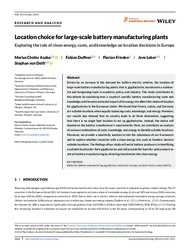Location choice for large‐scale battery manufacturing plants: Exploring the role of clean energy, costs, and knowledge on location decisions in Europe
DOI: https://doi.org/10.1111/jiec.13292
Persistent URL: http://resolver.sub.uni-goettingen.de/purl?gldocs-11858/10272
Persistent URL: http://resolver.sub.uni-goettingen.de/purl?gldocs-11858/10272
Supplement: https://doi.org/10.1016/j.jclepro.2020.121428, https://www.iea.org/data-and-statistics/data-product/emissions-factors-2021
Asaba, Marius Chofor; Duffner, Fabian; Frieden, Florian; Leker, Jens; von Delft, Stephan, 2022: Location choice for large‐scale battery manufacturing plants: Exploring the role of clean energy, costs, and knowledge on location decisions in Europe. In: Journal of Industrial Ecology, Band 26, 4: 1514 - 1527, DOI: 10.1111/jiec.13292.
 |
Dokument öffnen: |
Driven by an increase in the demand for battery electric vehicles, the location of large‐scale battery manufacturing plants, that is, gigafactories, has become a substantial and burgeoning topic in academia, policy, and industry. This study contributes to this debate by examining how a country's specific battery manufacturing costs and knowledge and the environmental impact of its energy mix affect the choice of location for gigafactories in the European Union. We found that France, Latvia, and Germany are suitable locations when equally balancing costs, knowledge, and energy. However, our results also showed that no country leads in all three dimensions, suggesting that there is no single best location to set up gigafactories. Instead, the choice will depend on the battery manufacturer's requirements. Here, we contribute an analysis of various combinations of costs, knowledge, and energy to identify suitable locations. Moreover, we provide a sensitivity analysis to test the robustness of our framework and to explore whether countries with a clean energy mix, such as Sweden, become suitable locations. The findings of our study will assist battery producers in identifying a suitable location for their gigafactories and will provide the basis for policymakers to attract battery manufacturing by directing investments into clean energy.
Statistik:
ZugriffsstatistikSammlung:
Schlagworte:
batteriesbattery manufacturing
gigafactory
industrial ecology
location choice
sustainability
This is an open access article under the terms of the Creative Commons Attribution‐NonCommercial‐NoDerivs License, which permits use and distribution in any medium, provided the original work is properly cited, the use is non‐commercial and no modifications or adaptations are made.

